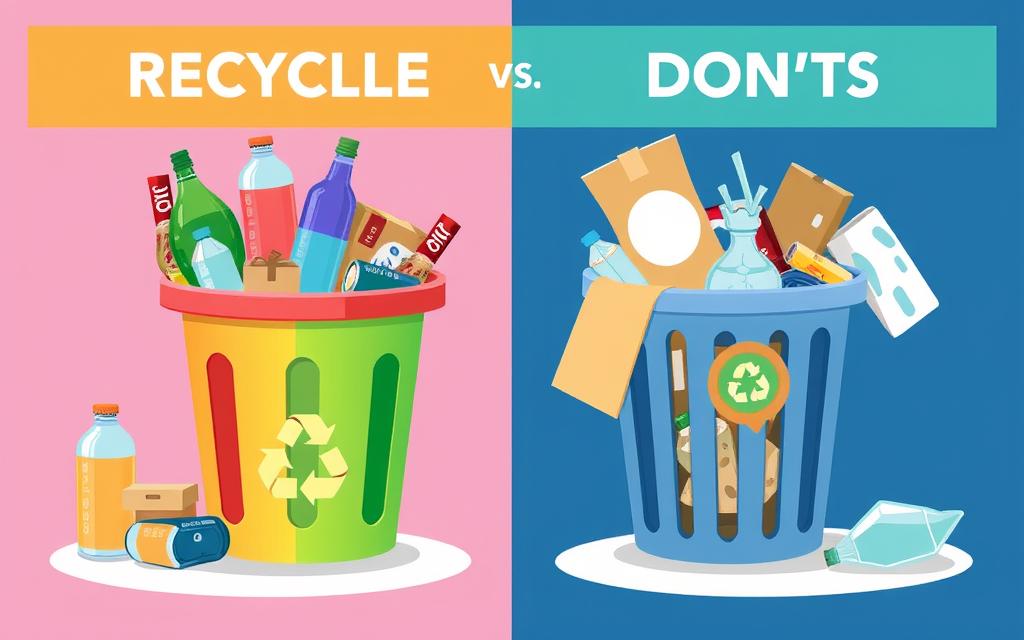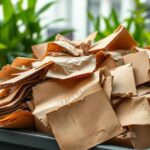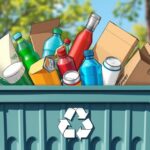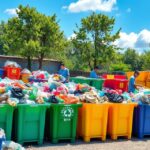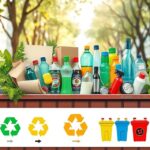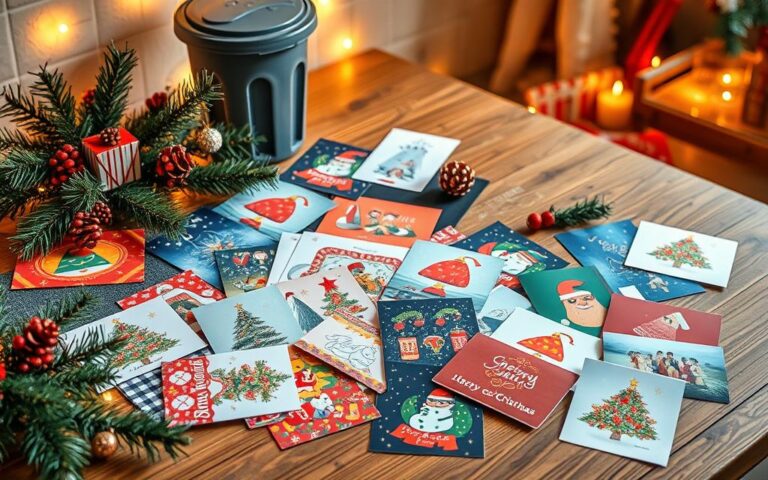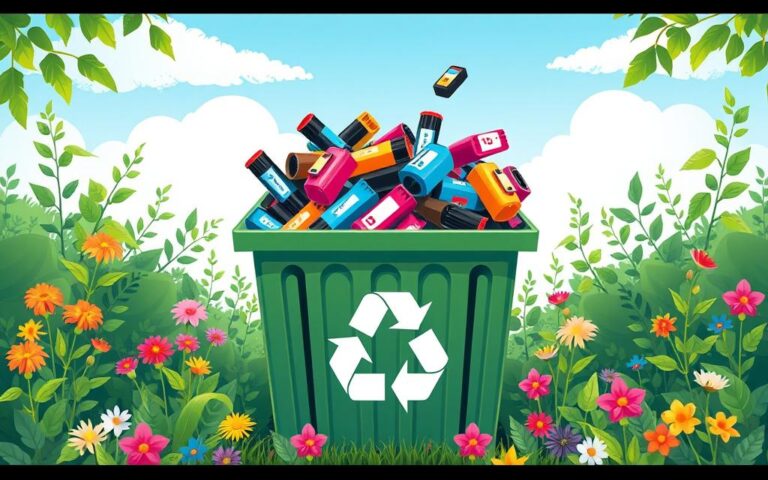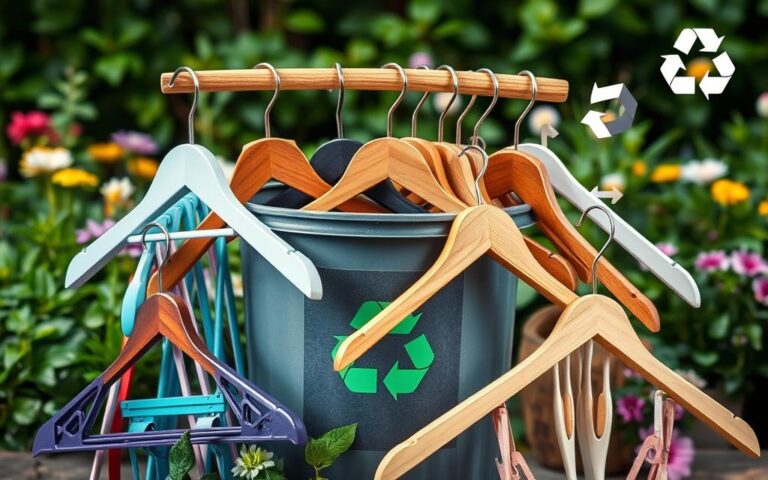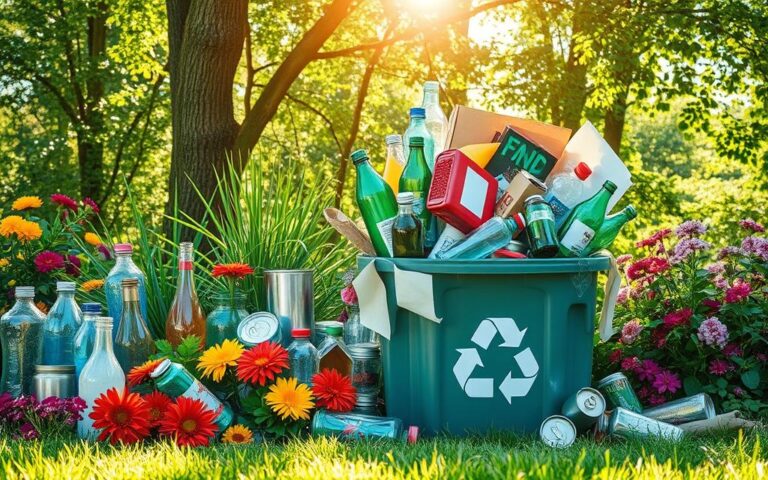What Can I Put in the Recycle Bin? Do’s and Don’ts
Recycling is crucial for helping our planet. Yet, many of us are unsure about what to recycle. Shockingly, 25% of items in recycling bins can’t actually be recycled. This increases costs and can slow down recycling. By learning what goes in the bin, you can really help the earth.
This guide will tell you what you can and can’t recycle. It will help you develop better recycling habits. You can recycle clean newspapers, magazines, and cardboard. But, dirty containers and plastic bags could spoil the recycling batch. We’ll explore what’s recyclable, tackle common mistakes, and share tips to improve your recycling.
Understanding Recycling Basics
Learning about recycling is key for helping our planet. It’s about knowing how recycling reduces landfill waste, saves natural resources, and cuts greenhouse gases. By adopting a mindset focused on recycling, we can make steps towards a healthier Earth.
The Importance of Recycling
Recycling is crucial for our environment. It tackles big issues by:
- Reducing waste in landfills.
- Saving energy and resources for making new materials.
- Lessening greenhouse gas emissions from waste management and material production.
Common Misconceptions About Recycling
Many people get recycling wrong because of common myths. One big myth is thinking all items with a recycling symbol are recyclable everywhere. In truth, only some plastics are widely accepted. This confusion leads to mistakes in recycling bins, with dirty items possibly ruining loads of recycling. These errors slow down the recycling process.
There’s also a mistake about recycling things that shouldn’t be recycled. For example, plastic bags can damage recycling machines and must be thrown away correctly. Understanding these false beliefs helps everyone recycle better and support a sustainable world.
| Common Misconceptions | Reality |
|---|---|
| All items with a recycling symbol can be recycled. | Only specific types of plastics are universally accepted. |
| Dirty items do not affect recyclability. | One dirty item can contaminate an entire truckload of recyclables. |
| Plastic bags can be recycled curbside. | Plastic bags can cause delays and damage; they require special handling. |
| Food-contaminated cardboard can be recycled. | Once contaminated, cardboard or paper is no longer recyclable. |
| All household waste can go in recycling bins. | Only certain materials are valid for recycling; others should go to designated facilities. |
What Can Put in the Recycle Bin?
It’s key to know what goes into the recycle bin to manage waste well. Every area has its own rules, and what’s recyclable can greatly differ. By understanding local recycling rules, you help make recycling better.
Accepted Materials in Recycling
There are many items you can recycle if prepared right. Accepted things include:
- Paper: Flattened cardboard, cereal boxes, office papers, newspapers, and magazines.
- Plastics: Bottles and jars (with necks), jugs, and some plant pots.
- Metal: Aluminium, tin, and steel cans, and empty aerosol cans.
- Glass: All glass food and drink bottles and jars.
- Batteries: Many types, including AAA, AA, and rechargeable batteries.
- Motor oil: Should be in a clear, leakproof plastic jug.
Recycling rules can vary, especially for plastics and metals. Some places might take bottle caps, others won’t. Always check your area’s specific recycling rules to recycle right.
Local Guidelines and Variations
Some things shouldn’t go in the recycle bin. Items like coffee cups, plastic bags, and take-out containers might be a no-no because they can contaminate. For example, Philadelphia’s program says no to things like needles, stressing safe disposal.
Before recycling, take off any shipping materials and don’t bag recyclables. Following these steps helps recycling work smoothly and follows local rules. For more info on recycling in your place, check out the local recycling guidelines.
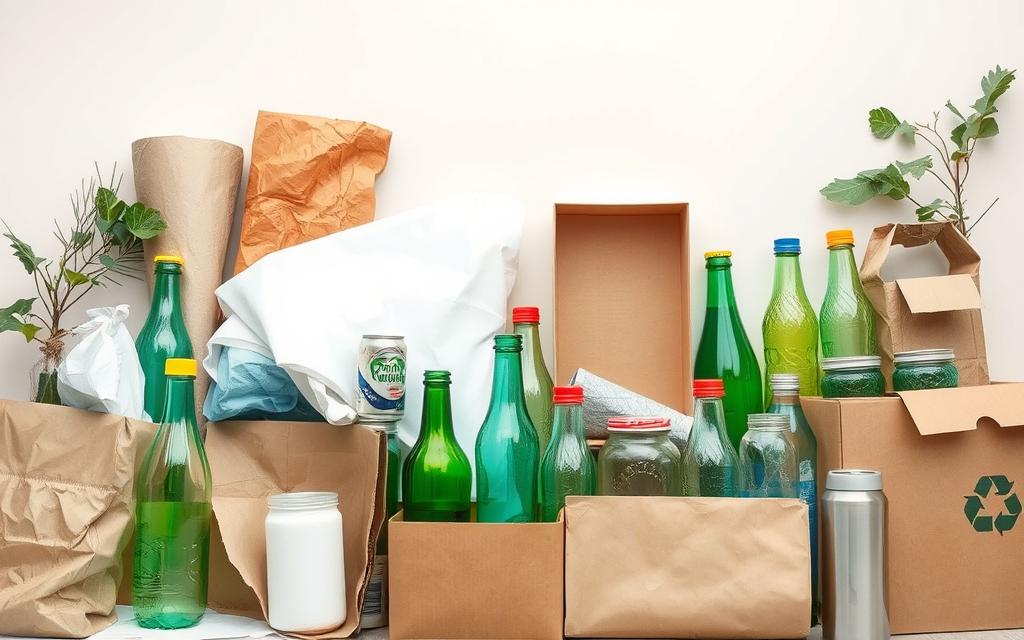
The Don’ts of Recycling
Understanding what not to recycle is key. Putting wrong items in the bin can contaminate recycling processes. It’s vital to know the don’ts to keep recyclable materials pure.
Items That Should Not Be Recycled
Many everyday items are wrongly thought to be recyclable, causing confusion. Knowing what not to recycle helps avoid mistakenly trashing items that could be reused. Important non-recyclables include:
- Plastic bags
- Plastic utensils and straws
- Snack bags
- Styrofoam cups and plates
- To-go containers
- Napkins and paper towels
- Tissues and food-soiled paper
- Paper coffee cups (due to plastic liners)
Many don’t know plastic bags must go back to stores for recycling. They can’t be put in home bins.
The Impact of Contamination
Contamination is a big problem for recycling. Wrong items in bins mess up sorting. This can make whole loads unrecyclable. Mixed materials in single-stream recycling increase contamination.
In California, folks produce 5.2 pounds of waste each day. About 58% avoids landfills. But, 68% of people wrongly think all items with recycle symbols are recyclable. This mistake harms recycling efforts. Education is needed to avoid this. Correct recycling cuts greenhouse gases from solid waste by 11% in certain areas.
Best Practices for Effective Recycling
Understanding and using specific guidelines improves recycling. This section talks about cleaning, preparing, and sorting recyclables for better processing.
Cleaning and Preparing Recyclables
Keeping recyclables clean and dry is key. Make sure food containers are rinsed well. Food left on them can spoil the whole recycled batch. Do not use plastic bags for recyclables, as they jam the machines. Stick to recycling common items and avoid wish-cycling.
Separating Recyclables by Type
Sorting items makes recycling more efficient. Know what your local program takes. For plastics, check the bottom for #1 and #2 symbols. Only some places take #3 to #7 plastics. Check with your recycling service first. Also, put caps back on bottles so they stay whole in the process.
Recycling does more than reduce landfill waste. By sorting and cleaning right, we support a greener future. For extra tips, check this guide. It has great advice on recycling habits.
| Recyclable Type | Preparation Guidelines |
|---|---|
| Plastic Bottles | Rinse and cap before recycling. |
| Cardboard | Remove tape and plastic wrap before recycling. |
| Paper | Keep it dry and free of contaminants. |
| Metal Cans | Rinse and remove labels if possible. |
| Glass | Do not include dishware or drinking glasses; check local guidelines. |
By following best practices, we make recycling more effective. This helps keep our planet clean and sustainable.
Conclusion
It’s crucial to follow recycling rules to help the planet and make recycling work better. In 2018, the US made 292.4 million tons of waste. Knowing what to recycle is now more important than ever. This conclusion shows how we can all help by making smart choices, thus cutting down waste a lot.
The numbers are worrying; recycling rates dropped to 32.1%, with only 9% of plastics recycled in 2018. We need to let more people know about recycling. By cleaning recyclables and not mixing them with the wrong items, we can make a big difference. This way, trash turns into new items, helping both the environment and saving resources.
Looking ahead, teaching people and working together in our communities are key to better recycling. If we all focus on Reduce, Reuse, and Recycle, and join local recycling efforts, we can reduce trash in landfills and move towards a greener future. Let’s all promise to recycle better, for a cleaner world.
FAQ
What can I put in the recycle bin?
In your recycling bin, you can put clean, dry paper, cardboard, and metal cans. You can also include plastics like PETE (#1) and HDPE (#2). It’s key to check your local recycling rules for more details.
Are all plastic items recyclable?
Not every plastic item can be recycled. Only certain plastics are widely accepted. Check what your local facilities allow.
What items should I avoid putting in the recycling bin?
Don’t put plastic bags, greasy pizza boxes, or dirty food containers in the bin. They contaminate the recycling and increase landfill waste.
Why is it important to clean recyclables before placing them in the bin?
Cleaning your recyclables stops food residue from causing contamination. This keeps the recycling stream clean. If items get contaminated, they might end up in a landfill.
Can I recycle items with the recycling symbol on them?
An item having a recycling symbol doesn’t always mean it’s recyclable. Only place materials in the bin if they match your local guidelines.
How can I effectively separate my recyclables?
By separating recyclables like paper, metal, and plastic, you enhance the recycling process. It makes items cleaner. It also lets recycling centers sort materials easier.
What is the impact of contamination in recycling?
Contamination raises processing costs in recycling. It can make whole loads unrecyclable. This hurts our recycling efforts and adds to landfill waste.
How can I stay informed about local recycling guidelines?
To keep informed, visit your local council or municipality’s website. They provide up-to-date recycling info, what materials they accept, and guidelines for your area.

